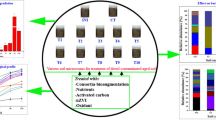Abstract
Ex-situ bioremediation of leached cynamonic forest soilat initial diesel oil contamination of 6000 mg kg-1, 4000 mg kg-1 and 2000 mg kg-1 was investigated afterbiostimulation with inorganic fertilizers. It was foundthat the added nutrients had no effect on the decontamination of polluted soils. A precise and reliable approach for evaluation of the biodegradation process is proposed. It comprisesapplication of sensitive and easily accessible diagnostic parameters and relations, calculated on the basis of n-alkanes andisoprenoids – pristane (2.6.10.14-tetramethylpentadecane,i-C19H40) andphytane (2.6.10.14-tetramethylhexadecane,i-C20H42) distribution.
Similar content being viewed by others
References
Alexander M (1991) Research needs in bioremediation. Environ. Sci. Technol. 25: 1972–1975
Atlas RM (1981) Microbial degradation of petroleum hydrocarbons: an environmental perspective. Microbiol. Rev. 45: 180-209
Atlas RM (1984) Petroleum Microbiology. MacMillan, New York
Biggar KW,Demque DE &Heroux JA (1997) Land treatment of diesel contaminated sand. Canadian Geotechnical Journal 34: 421-431
Bongiovanni R,Borgarello E &Pelizzetti E (1989) Oil spills in the aquatic environment: the chemistry and photochemistry at water/oil interface. La Chimica e L'Industria 71: 12-17
Braddock J &McCarthy K (1996) Hydrologic and microbiological factors affecting persistence and migration of petroleum hydrocarbons spilled in a continuous-permaforst region. Environ. Sci. Technol. 30: 2626-2633
Braddock J,Ruth M,Catterall P,Walworth J &McCarthy K (1997) Enhancement and inhibition of microbial activity in hydrocarbon-contaminated arctic soils: implications for nutrientamended bioremediation. Environ. Sci. Technol. 31: 2078-2084
Bragg JR,Prince RC,Harner EJ &Atlas RM (1994) Effectiveness of bioremediation for the Exxon Valdez oil spill. Nature 368: 413-418
Braun K,Leavit M,Sanseverino J &Rightmyer J (1992) Bioremediation: in-situ and ex-situ application for refineries. Marriott/ Sheraton, New Orleans
Chaineau C,Morel J &Oudot J (1995) Microbial degradation in soil microcosms of fuel oil hydrocarbons from drilling cuttings. Environ. Sci. Technol. 29: 1615-1621
Churchill SA,Griffin RA,Jones LP &Churchill PF (1995) Biodegradation rate enhancement of hydrocarbons by an oleophilic fertilizer and rhamnolipid biosurfactant. J. Environ. Qual. 24: 19-28
De Jonge H,Freijer JI,Verstraten JM,Westerveld J &Van der Wielen FWM (1997) Relation between bioavailability and fuel oil hydrocarbon composition in contaminated soils. Environ. Sci. Technol. 31: 771-775
Douglas GS,Bence AE,Prince RC,McMillen SJ &Butler EL (1996) Environmental stability of selected petroleum hydrocarbon source and weathering ratios. Environ. Sci. Technol. 30: 2332-2339
Fayad NM,Edora RL,El-Mubarak AH &Polancos Jr AB (1992) Effectiveness of a bioremediation product in degrading the oil spilled in the 1991 Arabian gulf war. Bull. Environ. Contam. Toxicol. 49: 787-796
Geerdink MJ,Loosdrecht MCM van &Luyben KCA (1996a) Biodegradability of diesel oil. Biodegradation 7: 73-81
Geerdink MJ,Loosdrecht MCM van &Luyben KCA (1996b) Model for microbial degradation of nonpolar organic contaminants in a soil slurry reactor. Environ. Sci. Technol. 30: 779-786
Kerry E (1993) Bioremediation of experimental petroleum spills on mineral soils in the Vestfold Hills, Antarctica. Polar. Biol. 13: 163-170
Kovacheva KI &Belcheva RC (1994) Method for determination of total petroleum hydrocarbons in soils. Anal. Lab. 3: 177-182
Lee C,Russell NJ &White GF (1995) Rapid screening for bacterial phenotypes capable of biodegrading anionic surfactants: development and validation of a microtitre plate method. Microbiology 141: 2801-2810
Lindstrom JE,Prince RC,Clark JC,Grossmann MJ,Yeager TR,Braddock JF &Brown EJ (1991) Microbial populations and hydrocarbon biodegradation potentials in fertilized shoreline sediments affected by the T/V Exxon Valdez oil spill. Appl. Environ. Microbiol. 57: 2514-2522
Margesin R & Schinner F (1997a) Efficiency of indigenous and inoculated cold-adapted soil microorganisms for biodegradation of diesel oil in alpine soils. Appl. Environ. Microbiol. 63: 2660-2664
Margesin R &Schinner F (1997b) Bioremediation of diesel-oilcontaminated soils at low temperatures. Appl. Microbiol. Biotechnol. 47: 462-468
Margesin R &Schinner F (1998) Oil biodegradation potential in alpine habitats. Arctic Alpine Res. 30: 262-265
Milina R,Pavlova A,Kovacheva K &Ivanov V (1999) Distribution of n-alkanes in diesel fuel contaminated soils. Oil and Chemistry 3-4: 15-21
Mischustin EN (1954) Microorganisms and soil natural attenuation. Moscow
Oberbremer AR,Muller-Hurting R &Wagner F (1990) Effect of the addition of microbial surfactants on hydrocarbon degradation in a soil population in a stirred reactor. Appl. Environ. Biotechnol. 32: 485-489
Oudot J (1994) Weathering rates of oil components. Analysis 22: M16-M21
Owens EH,Harper JR,Robson W &Boehm PD (1987) Fate and persistence of crude oil stranded on a sheltered beach. Arctic 40: 109-123
Papazova D &Pavlova A (1999) Development of a simple gas chromatographic method for differentiation of spilled oils. J. Cromatogr. Sci. 37: 1-4
Prince RC,Emendorf DR,Lute JR,Hsu CS,Hauth CE,Senius JD,Dechert GJ,Douglas GD &Butler EL (1994) Hopane as a conserved internal marker for estimating the biodegradation of crude oil. Environ. Sci. Technol. 28: 142-145
Pritchard PH &Costa CF (1991) EPA's Alaska oil spill bioremediation project. Environ. Sci. Technol. 25: 372-379
Smith VH,Graham DW &Cleland DD (1998) Environ. Sci. Technol. 32, 3386
Turin I (1937) Soil organic. Moscow
USDA (1996) Soil Survey Laboratory Methods Manual, Soil Survey Investigations Report No. 42
Wang ZD,Fingas M &Page DS (1999) Oil spill identification: review. J. Cromatogr. A 843 369-411
Wang ZD,Fingas M &Sergy G (1994) Study of 22-year-old Arrow oil samples using biomarker compounds by GC/MS. Environ. Sci. Technol. 28: 1733-1764
Wang ZD,Fingas M &Sergy G (1995) Chemical characterization of crude oil residues from an arctic beach by GC/MS and GC/FID. Environ. Sci. Technol. 29: 2622-2631
Wang ZD,Fingas M,Blenkinsopp S,Sergy G,Landriault M,Sigouin L &Lambert P (1998) Study of the 25-year-old nipisi oil spill: Persistence of oil residues and comparisons between surface and subsurface sediments. Environ. Sci. Technol. 32: 2222-2232
Wardell LJ (1995) Potential for bioremediation of fuelcontaminated soil in Antarctica. J. Soil Contamination 4: 111-121
Zhang Y &Miller RM (1992) Enhanced octadecane dispersion and biodegradation by a Pseudomonas rhamnolipid surfactant (biosurfactant). Appl. Environ. Microbiol. 58: 3276-3282
ZoBell CE (1973) Bacterial degradation of mineral oils at low temperatures. In: Ahearn DG &Meyers SP (Ed) The microbial degradation of oil pollutants (pp 153-161). Publication no. LSU-SG-73-01. Center for Wetland Resources, Louisiana State University, Baton Rouge
Author information
Authors and Affiliations
Rights and permissions
About this article
Cite this article
Seklemova, E., Pavlova, A. & Kovacheva, K. Biostimulation-based bioremediation of diesel fuel: field demonstration. Biodegradation 12, 311–316 (2001). https://doi.org/10.1023/A:1014356223118
Issue Date:
DOI: https://doi.org/10.1023/A:1014356223118




